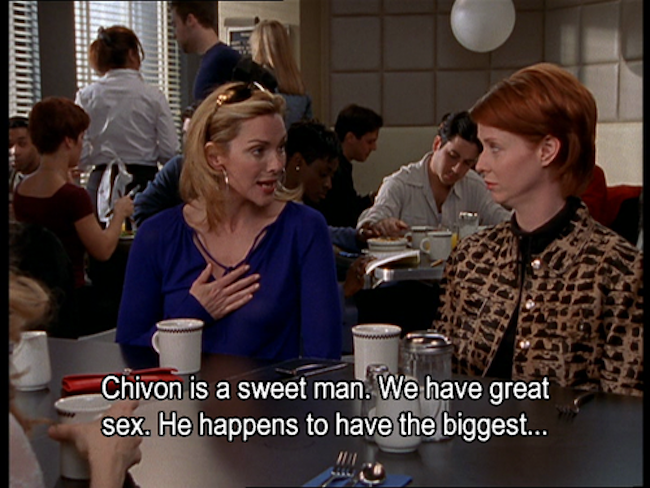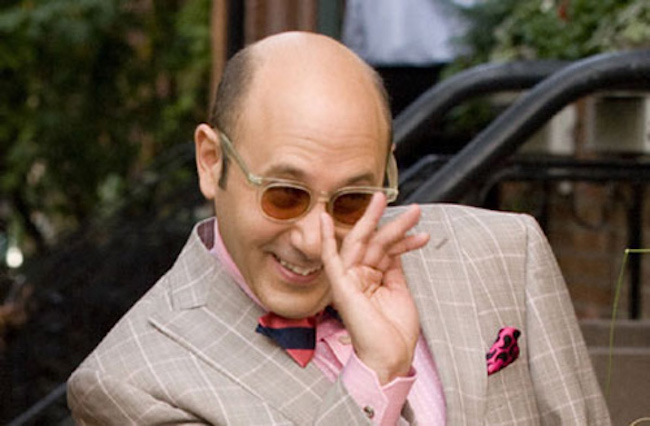Like many 20-something-year-old fans of the show, my first interaction with Sex and the City was being forbidden to watch it. “Your mum’s watching Sex and the City,” my dad would shout at me — the sultry salsa theme-tune followed by the swift closing of the living room door. In the years that followed I caught glimpses every so often. The episode where Carrie wants to smoke weed after she’s been dumped via a post-it note the first episode I watched in full. But, for a long time I could not understand what it was about the show that gripped my mum so much. That was, until I left home for university, discovered the show for myself and devoured every season. The perfect distraction from the mundanity of uni, I instantly fell in love with the Manolo Blahniks and SJP’s dulcet tones.
Having moved away from home to a far more glamorous city, and making a tight group of female friends, I saw certain details of my life reflected in the show. Sure, I didn’t have the financial stability of the characters, but I enjoyed some of the same freedom. I didn’t know Charlotte, Samantha and Miranda exactly, but I knew iterations of them. The way female friendship was depicted was ultimately what resonated with me most. I still well-up during the scene in which Charlotte says that, maybe her best friends are actually her soulmates, and that “we could just let men be these great, nice guys to have fun with”, or when Carrie walks Miranda down the aisle at her mother’s funeral, because she’s not strong enough to do it alone.
But, despite of all this joy it has brought me, I find myself having an increasingly complex relationship with the show. Namely, I am the complete antithesis of the women the show represents (i.e. not a straight, white woman). And, held up to the standards of 2018, there’s a lot of issues to be addressed around SATC’s dearth of diversity.
“No Ifs, Ands, or Butts is 30-minutes of wince-inducing racial cliches intended as an enlightening examination of modern interracial relationships.”
So I couldn’t help but wonder… with 20 years passing since the show’s debut, should we be focusing less so on celebrating the gaudy outfits and sexual indecency of the show, and more on the issues of diversity, representation and low-key racism? In order to work through the myriad of problems I have with Sex and the City, I started speaking to a selection of queer/non-white people, and organised a script-read of the show’s first episode at Pilot LightTV Festival in Manchester, with an entirely non-white cast. Like the Woke Charlotte memes that went viral last year, I didn’t want to just erase the problems with the show, but instead create a debate around them.
Perhaps the most excruciating example of the mishandling in representation of men and women of colour is season three episode, No Ifs, Ands, or Butts — AKA, the episode where Samantha dates a black guy. It’s 30-minutes of wince-inducing racial cliches intended as an enlightening examination of modern interracial relationships. Samantha, she of voracious sexual appetite, claims she “doesn’t see colour only conquests” [ding] and ends up sleeping with Chivon, a rap producer [ding ding], much to the chagrin of his sister Adeena, the owner of a soul food restaurant [ding ding ding].

The episode follows Adeena’s attempts to do everything in her power to split the couple up. Sure, it’s all well and good to highlight the realities of being in an interracial relationship, but in painting Adeena as a bitter black woman, the show depicts Samantha as the one in the right and the black woman as the one with the problem. Catherine, a SATC fan I spoke to when preparing for the script-read, pointed out this was a disappointing trope seen too often on television — “they paint every black woman as angry and jealous”.
We do, at least briefly, get to see a normalised interracial relationship when Miranda hooks up with a doctor who lives in her building in season six, but for a show that examines modern relationships set in New York, this hardly seems like enough.
“In framing Stanford and Anthony as extensions of their straight female counterparts, the show reduces their existence to that of fun accessory. Not only that, both represent a very narrow cliché of a gay man — wealthy, white, fabulously camp and bitchy.”
Then there’s the way in presents LGBTQ characters and storylines. Sex and the City is a show many gay men have gravitated towards. Yet, despite this and the fact the show’s creator Darren Star is gay, its LGBTQ characters haven’t exactly been given a fair run. Sex and the Cityhas only two recurring gay characters, Carrie and Charlotte’s respective GBFs — Stanford Blatch and Anthony Marantino. In framing them as extensions of their straight female counterparts, the show reduces their existence to that of fun accessory. Not only that, both represent a very narrow cliché of a gay man — wealthy, white, fabulously camp and bitchy.
Invariably, Carrie and Charlotte conspire to set up Stanford and Anthony. A boring and predictable sub-story ensues, leading to the painfully obvious conclusion that — surprise! — don’t hook up your two gay friends just because they’re both gay! To add insult to injury, in the film adaption Sex and the City 2 (this is the first and last time I will mention this abomination), we inexplicably find Stanford and Anthony do, in fact, get married.

Beyond these lazy stereotypes, the show also propagates complete misunderstandings of sexuality and gender. In the season three episode Cock a Doodle Do! Carrie refers to the transgender women sex-workers who live in Samantha’s area as “half man, half woman, totally annoying”. And how could we forget the time Carrie panics on learning her new love interest is bisexual. After all, she ponders, isn’t that just a “layover on the way to gay town?” According to Suyin, another conflicted fan I spoke to in researching the show, to him it felt like any time an LGBTQ character was introduced, “they’re treated like a punchline”.
“The level of detail that went into writing these strong, independent female characters means that, in 2018, we’re still identifying ourselves with which character we are.”
When it comes to gender and sexuality politics, Sex and the City, ultimately, paints a very singular vision of feminism. One that, sadly, was repeated more recently in Lena Dunham’s Girls. For shows set in New York, a melting pot of different experiences and identities, both shows put forwards an extremely white, heteronormative experience.
Fortunately, we’ve now got shows like Broad City and Insecure, as well as web series like Ackee and Saltfish and Brown Girls, which give nuanced (and diverse!) representations of womanhood and female friendship.
But you do have to wonder — would these shows have existed had Sex and the City not paved the way? Another voice I spoke to when researching the show, Tara, described it as her “sexual education”. As a Catholic school student, Sex and the City was somewhere she could genuinely learn about sex as a teen. The level of detail that went into writing these strong, independent female characters means that, in 2018, we’re still identifying ourselves as Samanthas or Charlottes. Yes, the show didn’t do enough to try and deal with issues of representation, sexuality, gender etc., and it should most definitely be held to account for that, but it did open up conversations that we’re now able to have in more nuanced ways on TV today. The show walked (and in Manolos, to boot!) so that its successors could run.
In 2018, we can enjoy shows that explore women and female friendships with a much wider and more nuanced lens, but that’s not to say Sex and the City won’t always be my problematic fave.
